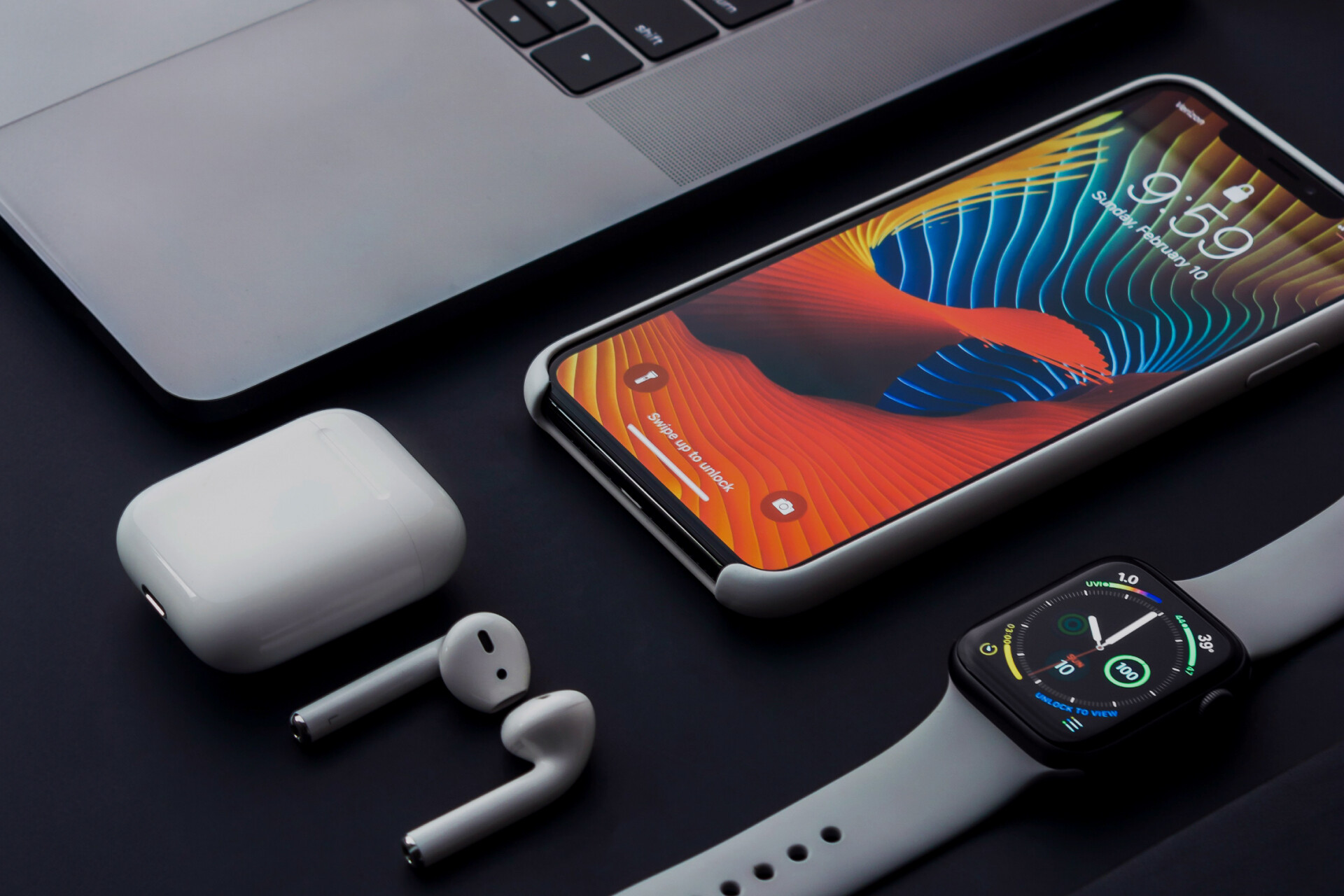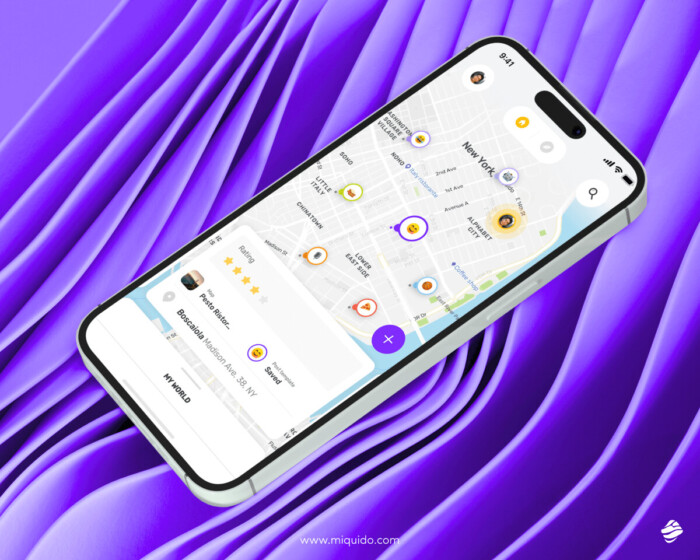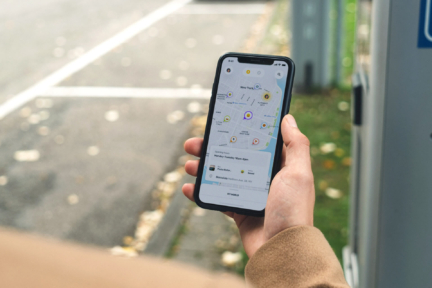The mobile app development market is highly competitive, meaning your application must be spot-on and bring real innovation to stay ahead of the game.
Believe me, the stakes are high — if your app doesn’t respond to current user needs and/or is outdated, people will shift to your competitors. It’s as simple as that.
So, why not bring the latest technology innovations to your application and stay one step ahead? This approach will pay off in time!
In this article, I present 13 game-changing trends in mobile app development.
Let’s dive right in!
Download a free report with 50+ of the latest facts and stats on the future of the mobile industry!
13 current trends in mobile app development
These top mobile app development trends have been on everyone’s lips in recent months.
1. AI and machine learning integration
The truth be told: artificial intelligence (AI) and machine learning (ML) have turned the mobile industry on its head. While they’re often used together, they have distinct roles.
AI enables machines to perform tasks that typically require human intelligence. ML uses algorithms to analyze data, identify patterns, and make predictions. Both have become essential tools for mobile developers who want to create engaging, user-centric experiences.
Here are some notable ML and AI trends in mobile apps:
- Personalization: AI and ML allow mobile apps to analyze user data (search history, purchases, app usage, etc.) to recommend content, products, or services relevant to each user. You’ll see this play out on top social media apps like Instagram– the average user is scrolling through the app and “stumbles” upon suggested posts they happen to like.
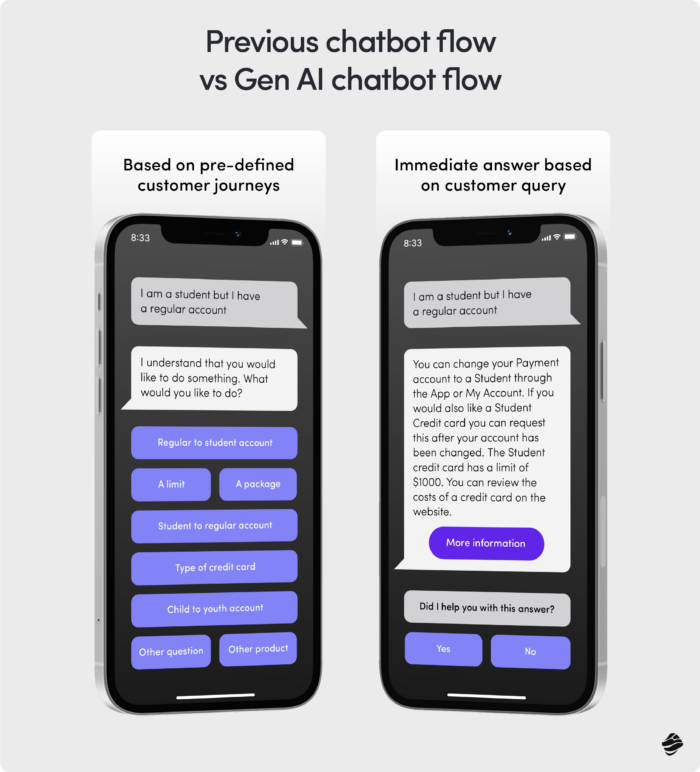
- Automation: AI-powered chatbots often provide 24/7 customer support within apps. These chatbots can answer user questions, resolve issues, and complete transactions with little to no need for human intervention.
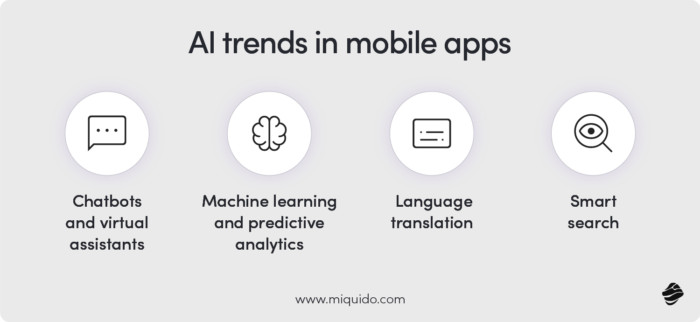
But, the adoption of AI and ML goes even deeper— healthcare, education, fintech, tourism, entertainment, e-commerce, and other industries can build apps that include powerful features like:
- Voice assistants (also known as speech recognition technology)
- Text recognition
- Image recognition
- Product recommendation system
- Face detection
- Object identification
- Predictive maintenance
AI and ML will continue to shape the future of app development, as the AI market is expected to reach $826 billion in 2030.
Don’t let yourself be the last to get on board. Go with AI software development and leave your competitors far behind!
2. AR/VR technology
This is one of the most apparent mobile app development trends for 2025.
If you’re still wondering what AR/VR solutions are and where you can find them, here’s a quick recap: Augmented Reality (AR) and Virtual Reality (VR) are technologies that enable the presentation of real-world elements in computer-generated versions.
Although AR and VR are two very similar concepts, their difference comes down to their required devices. AR can be easily reached from your smartphone, whereas, for VR, you need a headset to access a virtual world. Both aim to deliver virtual interactions and create seamless experiences.
How can a mobile app development company incorporate AR/VR solutions? That depends on the industry, but the gaming industry, retail, and education sectors may be core partakers.
Here are the most common uses:
- Education: gamified learning, digital learning materials, interactive classes
- e-Commerce: 3-dimensional product visualization, real-life photography simulation, virtual try-on solutions
- Entertainment: social media face filters, 360° virtual tours
- Healthcare: hospital navigation, patient education, surgery assistance
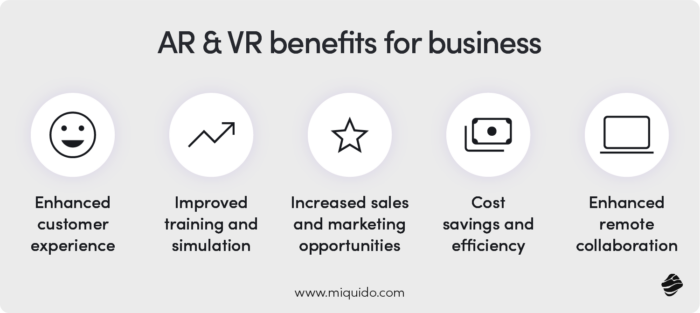
This list of AR/VR uses goes on and on. It would be highly challenging to mention all the possible applications of this technology. As I said, your choice should depend primarily on the industry and your target audience’s needs.
The benefits of this technology are countless! They include, but are not limited to:
- higher user engagement
- increased customer reach
- enhanced sales
And so much more!
So, why not consider implementing such solutions into your digital product?
3. Blockchain Technology
This cutting-edge technology, often associated with cryptocurrency, is quickly becoming a top mobile app development trend.
According to Grand View Research, the blockchain market, which includes mobile apps, was valued at $17.46 billion in 2023. Projections predict rapid growth, reaching about $1.4 trillion by 2030 at an 87.7% annual growth rate.
Here’s how tech giants are integrating blockchain into their mobile development systems.
- Improve data verification and transparency: All participants in a blockchain network share the same data, allowing everyone to see transaction details and changes. This enables users to verify data authenticity and transaction history. For example, developers are using blockchain Middleware in healthcare apps to let users automatically check and confirm medical data.
- Create decentralized applications: Blockchain enables the creation of DApps, which run on a decentralized network without relying on central servers or third-party services. For example, a DApp can let users securely manage digital assets directly on their phones, bypassing traditional financial institutions. What does this mean for developers? Improved uptime, reduced development costs, enhanced user privacy, and sufficient data privacy.
- Security enhancement: Blockchain stores data in a distributed ledger across a network of computers, making it highly tamper-proof. Altering data would require changing every copy of the ledger, which is nearly impossible. That’s why blockchain is ideal for mobile apps dealing with sensitive information like financial transactions or medical records.
Also, since Blockchain uses strong encryption to secure transactions, unauthorized access is adequately prevented– apps that enable mobile payments and in-app purchases can benefit from this.
4. Cross-platform development
Cross-platform app development means building one universal codebase that works perfectly fine on different operating systems, like iOS, Blackberry, Windows, or Android, instead of creating native codes separately. This widely popular technology allows mobile application developers to build code once using a single framework.
So, how can your business benefit from cross-platform development?
- Building an application that runs smoothly on the most widely used operating systems can help you reach a much broader target audience.
- You save time and money by using a shared codebase for different operating systems.
- Cross-platform apps are easier to maintain than native ones since you only test and fix bugs in one codebase.
- You significantly reduce time to market. With cross-platform frameworks, you can even save 30% of the entire app development time.
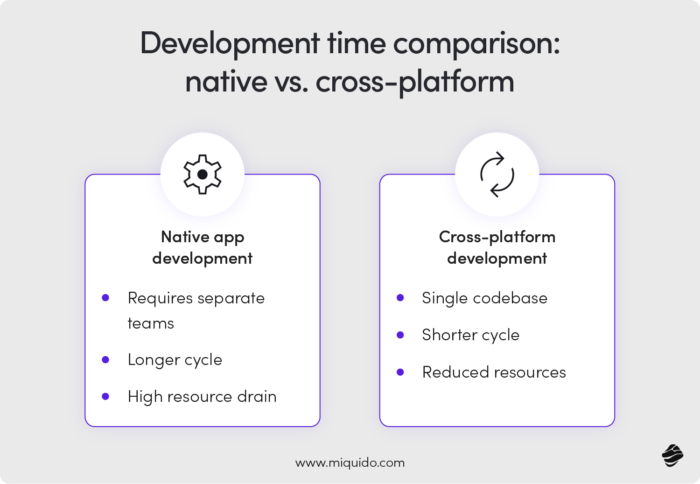
If you have decided on cross-platform development, you still have one crucial decision to make: which mobile framework to choose?
According to Statista, in 2023, software developers worked mainly with React Native and Flutter. These are merely two of the best mobile app development frameworks that will enhance cross-platform development in the coming years.
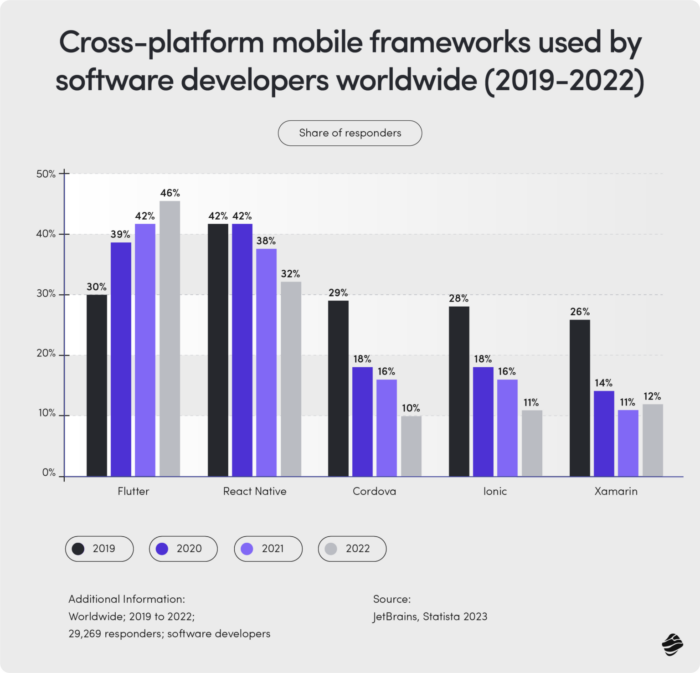
Choose our Flutter development services and leverage the full potential of this future-proof cross-platform framework!
5. Internet of Things (IoT)
We all love solutions that make our lives easier, and the Internet of Things (IoT) falls into this category. With this technology, you can control various domestic smart objects without getting up from the couch.
Connected devices, like LED light bulbs, domestic appliances, medical devices, or toys, can be managed via mobile applications. Basically, your mobile device can function as a remote control. As this technology has become more intelligent and responsive in recent years, people are becoming more willing to install it in their homes and offices.
The global IoT market is also on the rise—currently, there are more than 10 billion actively used IoT devices, and we can expect more than 25 billion of them by 2030.
6. Enhanced Security Measures
Reports revealed a 65% increase in cyber threats on mobile applications in January 2024 alone. So, it shouldn’t be news that the mobile app landscape prioritizes robust security measures to guard against these attacks. The app development industry also needs to adhere to strict data protection regulations.
Which app security measures are developers adopting?
- Data minimization: To protect user information, apps are being created to collect and retain only the minimum amount of personal data eeded to function properly.
- Granular permission settings: This allows smartphone users to opt out of certain data collection features. For instance, users can limit access to location data, microphone/camera, contacts, etc.
- Encryption: Advanced standards like AES-256 are now implemented to safeguard data in transit and storage.
- User authentication: This has evolved way beyond passwords. We now have multi-factor authentication, biometrics, and adaptive authentication systems that adjust security levels based on risk assessment.
Also, secure coding practices, API security measures, and tamper detection mechanisms are integrated to create multi-layered security on apps.
However, mobile developers must continuously balance security with user experience, stay ahead of threats, and comply with international data regulations.
7. Progressive Web Apps (PWAs)
Are progressive web apps still a thing? Absolutely!
Since its first release in 2015, PWAs have gained traction due to their ability to provide app-like experiences on web browsers. Google has remained a strong advocate, providing tools and frameworks like Angular, React, and Polymer to support PWA development.
Why PWAs are trending:
- They work across various devices and operating systems, reducing development costs and time.
- PWAs load faster and offer smooth, app-like interactions.
- They’re easy to install and programmed to update automatically, so app users always have the latest version.
- Modern PWAs can access device features like cameras, GPS, and sensors, bridging the gap with native apps.
- Security is strong. PWAs use HTTPS to enforce data security, which helps to reduce potential security lapses, content manipulation, and other damaging activities.
With PWAs, the focus remains on offering potential customers a seamless transition between web and app environments.
8. Voice-activated interfaces
Mobile apps continue to integrate voice recognition technologies more deeply, supporting features like navigation, search, and action execution. Speech-to-text functionality is also available for messaging and content creation.
Some apps even have dedicated voice assistants to provide more personalized experiences. This trend is particularly prominent in industries where voice interfaces can significantly enhance user convenience and accessibility. Some examples include:
- Smart home devices
- E-commerce
- Healthcare, and
- Entertainment.
There’s still room for improvement, though. For instance, developers face challenges ensuring accuracy across diverse acoustic environments, accommodating various accents/languages, and addressing privacy concerns related to voice data. But, as natural language processing technology evolves, we can expect even more sophisticated and context-aware voice interactions in future mobile applications.
9. User Experience (UX) design
UX design is another key factor in the competitive mobile app industry. That’s why the current focus is on how to improve mobile app conversion rate through simple yet engaging interfaces.
Developers now aim to enhance both the visual appeal and app functionality. Today’s mobile apps allow users to customize their visual preferences. So they can configure app themes, colors, and even icons.
Some notable UX trends include:
Incorporating “dark mode” to provide a visually comfortable option that decreases eye strain in low-light situations and improves battery life.
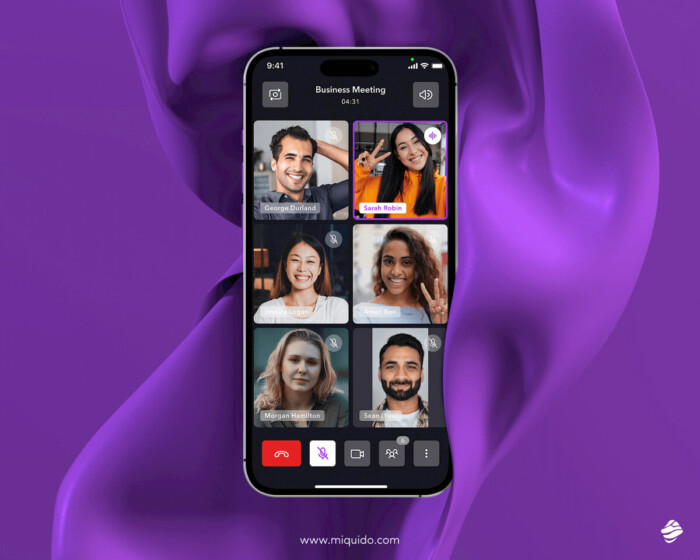
Gesture-based navigation offers a more instinctive and engaging experience by removing on-screen buttons and optimizing screen space. Instead of clicking buttons, users can simply swipe through various app screens.
Asymmetric menus and galleries. App designs have shifted from fixed patterns to more distinct, non-conventional layouts like we have below:
As mobile devices become more powerful, designers are experimenting with 3D elements, rounded corners, abstract designs, and parallax effects to further improve users’ experiences.
10. Mobile wallets
Apple Pay, Samsung Pay, Google Pay – I’m sure you’ve heard of them (or even use them regularly). These are examples of mobile wallets, i.e., virtual wallets that store the data from the payment cards on your mobile device and allow you to make contactless payments. All you need to do to make it work is pair your payment card with the mobile app. It’s as simple as that.
Mobile wallets are becoming an increasingly popular payment method among users worldwide. According to the Global Payment Report, 52.2% of online payments were carried out via mobile wallets, leaving practically no room for other payment methods.
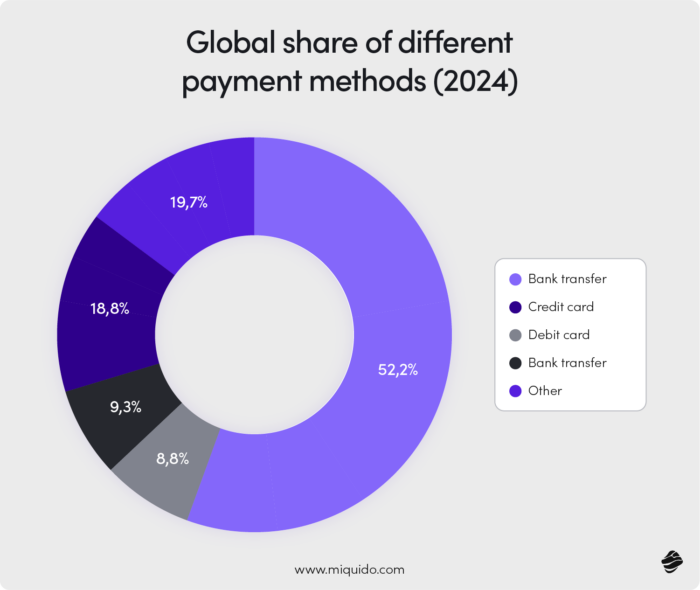
What does all this mean for you? As people slowly adapt to mobile wallets, the lesson must be learned: implement wallet integration into your application. This feature can make transactions much faster, easier, and more comfortable.
11. m-Commerce
Not so long ago, most small-sized online shops and global e-commerce platforms were selling their product only via websites. However, times have changed for good, and today even the smoothest website is no longer enough to boost sales.
So, if you want to achieve massive success in e-commerce, you must build a mobile app for your business. BUT, not any app that serves only to make purchases. Currently, mobile commerce (m-Commerce) is so much more! And here’s why.
Numerous surveys demonstrate that customers use e-commerce applications for various purposes. These apps come in handy when we need to compare prices, use discount coupons, or save our favorite items for later purchases.
This opens up new opportunities for you. Do not just sell products but deliver a seamless customer experience from start to finish. How can you achieve that? By implementing additional features, of course! Your next m-Commerce solution could include:
- product suggestions
- chatbots
- mobile wallets
- personalization, etc.
12. Wearables
Wearables are various electronic accessories designed to be worn on a person’s body. A smartwatch is probably the first thing that popped into your head. Am I right? This should come as no surprise, as smartwatches are the most notable example of this technology.
Even though wearables hit the mobile market a few years ago, this technology is now growing at a breakneck speed. Today, we can easily find smart jewelry, jackets, glasses, and more.
But if you still have any doubt that wearable technology brings the revolution to mobile apps, let the numbers speak for themselves:
- In 2022, there were over 1 billion wearable devices worldwide.
- The 2024 market revenue earned by medical wearables alone is about $42 million.
Wearable tech is the ideal solution for many industries, but it’s in healthcare that it can make a real difference. With it, you can build a patient management app or a fitness tracker that will monitor essential life-saving data, such as blood pressure, heart rate, or biosensors. Just make good use of what this innovative technology offers.
13. 5G technology
Last on our list of top mobile app development trends is 5G technology. This revolutionary technology has already transformed the way we use our mobile devices. We can predict that its impact on app development will be even more potent in the future.
By 2026, there will be 1.4 billion mobile devices connected to 5G. So, I’m not talking about the distant future here. The revolution has already begun!
5G is shaping the mobile market in many ways:
It contributes to the further development of already well-known solutions such as the Internet of Things, Augmented Reality, HD video streaming, or Supply Chain.
- It supports the ultra-fast transfer of massive amounts of data.
- It ensures a richer user experience and increases retention rates.
- It provides more connectivity for users worldwide.
- Most importantly, 5G unlocks new business opportunities.
Simply put, with 5G technology, the world of mobile apps will never be the same, whether we want it or not.
And that’s it! You may also want to check out the top mobile app development languages, which enhance the development of remarkable apps that continue to keep up with newer market demands.
In Closing
The 13 trends from above are already shaking up the mobile industry and will play an impactful role in the future.
As you can see, the mobile world is constantly evolving. So, to avoid falling behind your competitors, you must stay up to date with the latest trends. Don’t get me wrong — you don’t necessarily need to implement all of these innovations into your app. But, you’ll need to introduce new features to meet the changing user needs and expectations. And that’s why you must have a general overview of what trends are driving the mobile industry and be efficient in adapting them.
Choose us for your custom app development project and build a future-oriented mobile app tailored to your needs!

